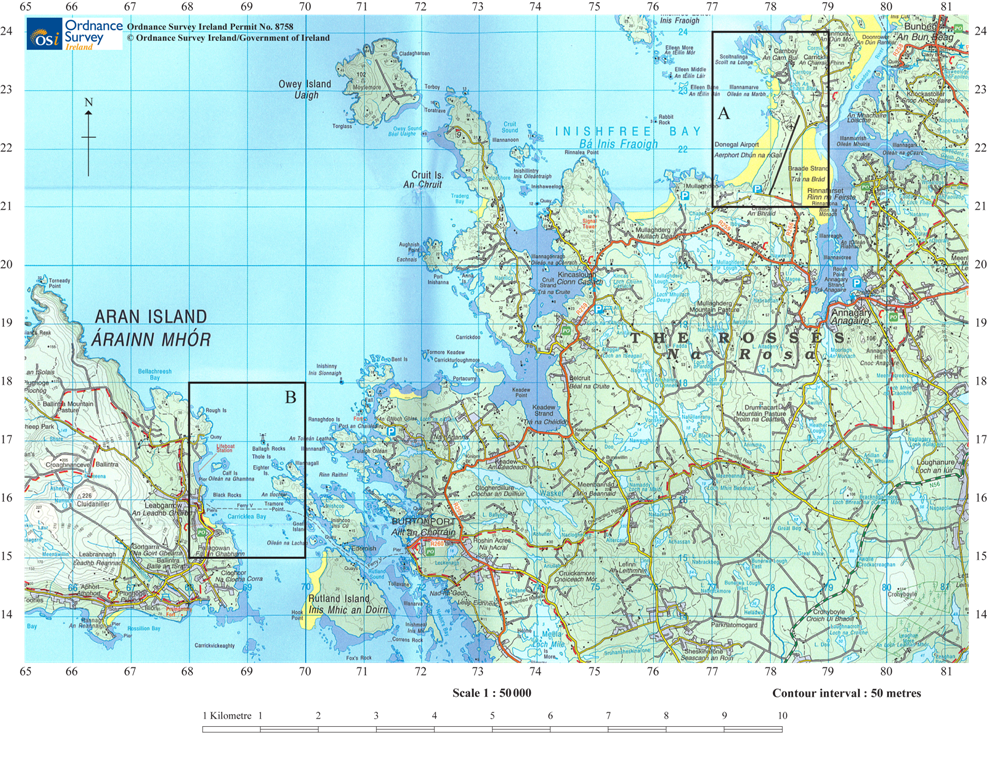| Date | November 2011 | Marks available | 4 | Reference code | 11N.2.bp.4 |
| Level | SL and HL | Paper | 2 | Time zone | |
| Command term | Describe | Question number | 4 | Adapted from | N/A |
Question
The map extract shows a coastal area in Ireland. The scale of the map is 1:50 000 and the contour interval is 50 metres.

[Source: Ordnance Survey Ireland Permit No. 8758 © Ordnance Survey Ireland/Government of Ireland]
Using map evidence, describe the effects of deposition in Area A.
Using map evidence, explain one likely conflict between types of human activity in:
(i) Area A,
(ii) Area B.
Examine the sources and impacts of waste disposal in oceans.
Markscheme
The most obvious signs of deposition in Area A are the two beaches [1 mark], one on either side of the airport. Each beach is about 1.5 km long [1 mark] and about 0.25–0.5 km wide [1 mark]. The beach to the east is wider than the beach to the west [1 mark]. It is possible that the entire neck of the peninsula (where the airport is built) is the depositional feature known as a tombolo [1 mark], joining a former island to the mainland. There are also small areas of deposition in square 77/23.
Award 1 mark for using the term “beach” and an additional 1 mark for each additional point made about them, or for further development of an idea.
Accept any other valid suggestion about deposition in Area A, provided that there is some map evidence to support it.
Most conflicts are likely to concern competition for land use.
(i) Area A
- Airport/local residents
- Airport/agriculture.
(ii) Area B
- Ferry traffic/fishing/recreational boaters (ferry vehicle route shown)
- Tourism/local interests/land uses
- Lifeboat station/prevention of other developments in the area.
Award up to 3 marks for each conflict that uses map evidence (names or grid references), is well explained and shows how two land uses are incompatible.
Sources may include:
- Agriculture in the form of pesticides and fertilizers
- Industrial waste, especially heavy metals (for example, Minimata mercury poisoning in Japan)
- Raw sewage from urban/residential developments
- Radioactive waste from power stations or the impacts of warm water as a by-product
- Disposal of oil waste from tankers
- Ship wastes including plastics.
Impacts may include:
- Eutrophication and algal blooms from fertilizers
- Bleaching of reefs from increased temperatures
- Damage to marine life from heavy metals or radioactive waste
- Changes to water clarity and turbidity from shipping and industry
- The impacts of oil waste on marine life and the littoral zone may also be
- considered.
To access bands E and F, answers should examine at least two sources and impacts, though do not always expect a balance.
Marks should be allocated according to the markbands.
Examiners report
Responses to this question were very weak at both levels, with most gaining more marks for part (b) than for part (a).
Most gained more marks for part (b) than for part (a).
Examples used were not always valid. For instance, the Trafigura event did not involve "waste disposal in oceans", nor could an accidental oil spill from a rig explosion really be considered as "waste disposal", so that a number of responses simply examined ocean pollution from any source.

